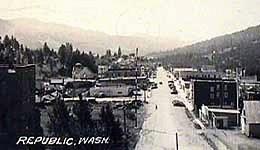On June 11, 1941, a mine-tailings reservoir belonging to the Knob Hill gold mine near Republic (Ferry County) breaks. When the 200-foot section of the dam bursts, it releases a cyanide-laden flood. One family rushes from their home moments before the flood destroys it. Five houses are destroyed along with a number of cars and trucks and large sections of highway. No lives are lost.
A 200-foot section of the dam burst at 3 a.m., apparently weakened by recent rains. The dam was estimated to be 1,200 feet wide and 50 feet high. The reservoir held vast quantities of poisonous tailings and contaminated water, which rushed down the Eureka Gulch not far from the center of town. Mr. and Mrs. Lonnie Priede, who lived beneath the dam, escaped with nothing but their pajamas. Mrs. and Mrs. W. D. Rick lost everything in their home and yard, including 300 chickens.
When mine employees saw the 200-foot section collapse, they helped spread the word downstream. The torrent took out a large section of a Highway No. 4.
It rushed into the San Poil River, where the cyanide-laden water killed many fish. "Several sportsmen visited the stream today in an effort to seine out as many large fish as possible before the poison could reach them," reported the Spokesman-Review. "But it proved futile as many of them were already dead and what were caught did not survive transplanting" (Spokesman-Review, July 13, 1941).
Farmers downstream were warned not to let their livestock go near the water.
The flood carried lumber, logs and trees through the gulch and lodged them on the banks and along the highway. It washed out the highway and traffic had to be detoured.
The Knob Hill mine itself was not in the path of the flood and operations continued as usual the next day.

